Last Updated on January 13, 2024 by Greg Gillson
I’ve put this resource together for you to answer your question: What birds are in my backyard in Arkansas?
This article lists and discusses the identification of the most common birds in your backyard. The birds chosen in this article are compiled from actual data from the citizen science program eBird. Thus, it is more accurate than some other similar articles you may find on the web. I provide pictures of each bird species mentioned and I’ll tell how to attract them to your backyard.
These are the most common backyard birds in Arkansas:
- Northern Cardinal
- Blue Jay
- American Crow
- Carolina Chickadee
- Tufted Titmouse
- Carolina Wren
- Red-bellied Woodpecker
- Mourning Dove
- Downy Woodpecker
- American Robin
- Northern Mockingbird
- White-throated Sparrow
- Eastern Bluebird
- European Starling
- American Goldfinch
- Red-winged Blackbird
- Dark-eyed Junco
- White-breasted Nuthatch
- House Finch
- Northern Flicker
- House Sparrow
- Common Grackle
- Indigo Bunting
- Red-eyed Vireo
- Brown-headed Cowbird
- Summer Tanager
Arkansas Birds and Birding in Arkansas State
eBird lists over 420 types of birds as occurring in the state of Arkansas.
The most common bird in Arkansas: the most frequently seen bird in the state is Northern Cardinal. It is reported on 62% of bird watching lists.
If you are serious about knowing the birds native to Arkansas, then check out eBird for Arkansas. It has recent sightings and photos, illustrated checklists with weekly abundance bar charts for state, counties, and individual hotspots of the best birding locations.
If you want to know about other people interested in birds in your area, join a local bird group. The American Birding Association maintains a list of bird watching clubs for each state.
Arkansas Bird Identification
This section is the species accounts. These are designed to help you to recognize birds you see in your backyard. I have used eBird to select the birds that are most common. “Common” means the birds seen most often throughout the year, not necessarily the most numerous.
Each species account starts with a photograph. In the identification section I am using size and shape and bill type before considering the color or patterns on the birds. I find these more reliable when trying to identify an unknown bird. Pay attention to body and tail shape and especially bill shape of birds you see, not just plumage color.
In the section on bird feeders and foods I tell how to attract each species. Not all types of backyard birds will come to feeders. But all backyard birds can be attracted with water. So don’t forget to add a birdbath to your bird feeding station.
Do you live in northwest Arkansas? Central Arkansas? Northern Arkansas? South Arkansas? Northeast Arkansas?
To appear in this article, most birds are widely distributed throughout the state and are often year-round residents. However, for those birds that are more localized in place or time, I list the general region and seasonality. Please see the section following these species accounts for the lists of common species by season.
Even if a species is found in a general area, they occur only in the habitat they prefer. So, the exact habitat of your neighborhood is important for the presence of absence of certain kinds of birds.
1. Northern Cardinal (Cardinalis cardinalis)
This is one of the most common and popular backyard birds in the eastern half of the United States.
 |
| Northern Cardinal. GeorgeB2. Pixaby |
Range in Arkansas: Northern Cardinals are year-round residents throughout Arkansas.
Identification:
Size: Cardinals are a bit smaller than American Robins, about the same size as Red-winged Blackbirds.
Shape: Plump body with fairly long full tail. Wispy crest.
Bill: Short, heavy, conical, pink.
Color: That bright red color is matched by few other birds. Black face. The female is more gray, but with hints of red in wings and tail, and has a crest, too.
Habitat, range & behavior: Cardinals are year-round residents in shrubby woodland edges.
Found from the eastern United States to Texas and Arizona south into Mexico.
That large conical bill is made for chewing seeds. Watch them crack open sunflower seeds, spit out the hulls, and pluck the kernel with their tongues!
Food and feeder preference: Black oil sunflower seeds. Many types of seeds, berries, nuts in larger hopper or tray feeders.
You may like my in-depth article on attracting Northern Cardinals.
2. Blue Jay (Cyanocitta cristata)
A common and well-known bird in the eastern half of the United States.
 |
| Blue Jay. skeeze. Pixabay |
Range in Arkansas: Blue Jays are year-round residents throughout Arkansas.
Identification:
Size: About that of American Robin.
Shape: Fluffy, large crested head, ample tail. Large strong legs.
Bill: Black, long and stout.
Color: Blue above, white below. Black neck collar. White patches in wing.
Habitat, range & behavior: Woodlands and towns.
Found in the eastern half of the United States. In summer into southern Canada.
Bold and brash. May bully smaller birds. Jays gulp lots of seeds or other food at once, storing it in their crop. Then they fly off and bury food items in a hidden cache.
Food and feeder preference: Omnivorous. They can quickly empty your feeder! Because they are also aggressive toward other feeder birds, some people put mesh cages around smaller bird feeders. Small birds can go through, squirrels and larger “pest” birds are prevented entry. Some people feed jays peanuts, perhaps away from the seed feeders.
3. American Crow (Corvus brachyrhynchos)
This larger all-black bird is common in cities and country. Its cawing call is familiar to most people.
 |
| American Crow. Greg Gillson |
Range in Arkansas: American Crows are year-round residents throughout Arkansas.
Identification: This is a key species for comparing with an unknown bird.
Size: About 17-1/2 inches long from bill tip to tail tip, though there is much size variation throughout its range. Larger than blackbirds and grackles. Smaller than ravens.
Shape: Thick neck, large head, rather short square-ended tail. Longer legs. In flight has rounded wing tips with each primary feather separated from others forming “fingers.”
Bill: As long as head, thick, black.
Color: Glossy black throughout.
Habitat, range & behavior: They prefer open areas with trees, fields, farms, cities.
They are common across most of the United States lower-48, except in the desert southwest. They move into southern Canada in summer.
They gather in evening communal roosts in large flocks that may number into the thousands and then move out at dawn into the surrounding area.
Food and feeder preference: Omnivorous, they feed on large insects, grain, small mammals, carrion. You probably don’t want these large entirely-black birds in your backyard feeders. So don’t feed table scraps to birds.
4. Carolina Chickadee (Poecile carolinensis)
Chickadees are common feeder birds throughout much of North America. This one is common in the southeastern United States.
 |
| Carolina Chickadee. GeorgeB2. Pixabay |
Range in Arkansas: Carolina Chickadees are year-round residents throughout Arkansas.
Identification:
Size: This small bid is the size of an American Goldfinch.
Shape: Round body, round head, longer tail.
Bill: Short, straight, stout.
Color: Gray above. Paler below. Black cap, white face, black bib.
Habitat, range & behavior: Lower elevation deciduous forests, wooded residential areas.
This chickadee is a resident in the southeastern US.
Chickadees cannot chew as sparrows do, so they take one large sunflower seed at a time from your feeder and fly off to a branch to pound it open with their stout bills.
Food and feeder preference: Most of their diet is insects, also seeds. They will eat black oil sunflower seeds from hopper feeders.
5. Tufted Titmouse (Baeolophus bicolor)
Related to chickadees, they lack the black bib, but have a crest instead.
 |
| Tufted Titmouse. anne773. Pixabay |
Range in Arkansas: Tufted Titmice are year-round residents throughout Arkansas.
Identification:
Size: A small bird, but a large titmouse, this species is larger than chickadees, about the size of a junco or House Finch.
Shape: Rounded body, long full tail, big head, long legs.
Bill: Short and stout, compressed (taller than wide), black.
Color: Dark blue-gray above, pale below. Black feathers around eye accentuates its size.
Habitat, range & behavior: Lives in deciduous forests with heavy canopy, parks.
Found in eastern and southeastern United States is expanding its range north and west.
Backyard bird feeders might be helping this species expand its range northward.
Food and feeder preference: Insects and seeds. At your hopper or tray feeder they like black oil sunflower seeds and suet.
6. Carolina Wren (Thryothorus ludovicianus)
This is a fairly common backyard bird in the much of the eastern United States.
 |
| Carolina Wren. theSOARnet. Pixabay |
Range in Arkansas: Carolina Wrens are year-round residents throughout Arkansas.
Identification:
Size: A smaller bird, between the size of American Goldfinch and House Finch.
Shape: Round body, short neck, flat head, long tail flipped about actively.
Bill: Fairly long, thin, pointed and slightly curved.
Color: Upper parts rusty brown with black bars on the wings and tail. A white eyebrow line and buff under parts.
Habitat, range & behavior: Shrubby thickets and brushy suburban yards.
It is found in the southeastern United States and Yucatan. Northern parts of range expand and contract depending upon harshness of winters.
Males sing throughout the year and are very loud for their size.
Food and feeder preference: Feed mostly on insects and spiders. They will feed on suet.
7. Red-bellied Woodpecker (Melanerpes carolinus)
This is one of the most common species in the eastern half of the United States.
 |
| Red-bellied Woodpecker. skeeze. Pixabay |
Range in Arkansas: Red-bellied Woodpeckers are year-round residents throughout Arkansas.
Identification:
Size: Fairly large for a backyard bird. Between a Starling and American Robin in size. Smaller than a Northern Flicker.
Shape: Stout with large head and short tail. Clings to tree trunk on strong short legs propped up with short stiff tail.
Bill: Long, chisel shaped.
Color: Pale gray body, many thin black-and-white bars across back and wings. Red nape, extending forward on crown on male.
Habitat, range & behavior: These birds are found in many woodland types, including oak, hickory and pine.
They are found from the eastern slope of the Rocky Mountains in the lower-48 states from Texas to extreme southern Canada, and eastward from Florida northward just to the southern edge of the New England states.
In typical woodpecker fashion, it hitches up the tree trunk and larger branches.
Food and feeder preference: This species eats insects and nuts. They may eat peanuts from a tray feeder and eat from a suet block.
8. Mourning Dove (Zenaida macroura)
Mourning Doves are the most widespread and most frequent backyard bird in the Lower 48 states of the United States.
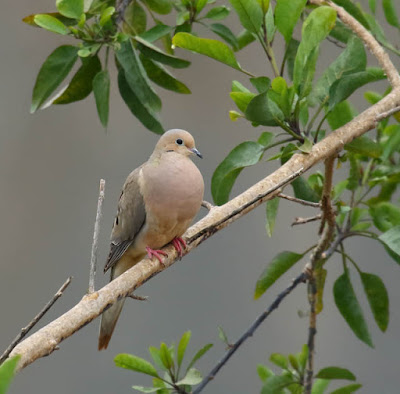 |
| Mourning Dove. Greg Gillson |
Range in Arkansas: Mourning Doves are year-round residents throughout Arkansas.
Identification: This is a key species for comparing with an unknown bird.
Size: About 12 inches long from bill tip to tail tip. About same size as Northern Flicker. Larger than American Robin. Slightly smaller than domestic city pigeon.
Shape: Very plump with a small round head. Tail is long and pointed. Legs are short.
Bill: Small and rather slender.
Color: Pale brown-pink body, darker wings and tail. White edges on side of tail.
Habitat, range & behavior: Semi-open areas such as urban areas, farmlands, woods.
It is a resident across the lower-48 states and Mexico, with some movement out of northern areas in winter.
Often seen perched on wires, fences. Their mournful cooing is a familiar spring birdsong.
Food and feeder preference: Mourning Doves eat seeds almost exclusively. Attract with black oil sunflower seeds on a large sturdy tray feeder or on the ground.
9. Downy Woodpecker (Dryobates pubescens)
This tiny woodpecker is found across the United States.
 |
| Downy Woodpecker. Greg Gillson |
Range in Arkansas: Downy Woodpeckers are year-round residents throughout Arkansas.
Identification:
Size: Bigger than a junco or House Finch. Smaller than a Red-winged Blackbird. About the same size as a White-crowned Sparrow, but with a much shorter tail.
Shape: Stocky with large head and short stiff tail.
Bill: Short, chisel shaped.
Color: Black-and-white striped head. Black wings with white spots. Solid white back. White under parts. Black tail with white outer tail feathers with black bars or spots. Male with small red spot at back of head.
Habitat, range & behavior: Found in small deciduous trees, willows, and even weed stocks such as teasel, especially near water.
Ranges coast-to-coast across all but northernmost parts of Canada and Alaska south to the southern US. Absent in the desert southwest.
Interestingly, I learned today that the males may more often be found in smaller plants and twigs, while females are more likely on tree trunks.
Food and feeder preference: Insects, fruits, and seeds. Gleans arthropods from the bark of trees. Attract with suet feeder. Will also eat black oil sunflower seeds.
10. American Robin (Turdus migratorius)
This familiar bird is a resident in the northern half of the United States and a winter visitor in the southern half.
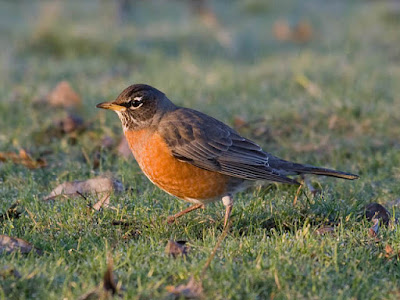 |
| American Robin. Greg Gillson |
Range in Arkansas: American Robins are year-round residents throughout Arkansas.
Identification: This is a key species for comparing with an unknown bird.
Size: 10 inches long from bill tip to tail tip. About the same size as a Blue Jay or one of the Scrub-Jays. Larger than Red-winged Blackbird. Smaller than a Mourning Dove.
Shape: Very plump with a fairly long tail.
Bill: Straight and fairly slender, curved at the tip.
Color: Gray-brown upperparts, rusty orange breast.
Habitat, range & behavior: Open woodlands, farmlands, urban parks and lawns.
Migratory, breeds north across Alaska and Canada. Resident in most of the United States (lower 48). Winters in the United States, Mexico, to central America.
Hops on your lawn turning head this way and that looking for food. Their caroling song is one of the early signs of spring in the north.
Food and feeder preference: Worms and other invertebrates in the lawn. May eat fruit from a tray feeder or the ground. Eat small berries from trees and bushes.
11. Northern Mockingbird (Mimus polyglottos)
This bird sings from exposed perches most of the year and often through the night. They have an unending supply of their own unique short phrases that they repeat about 3 times each, but frequently intersperse songs of other birds.
 |
| Northern Mockingbird. Greg Gillson |
Range in Arkansas: Northern Mockingbirds are year-round residents throughout Arkansas.
Identification:
Size: The length of an American Robin.
Shape: Slender and long tailed. Long legs.
Bill: Medium length, slender, slightly curved.
Color: Gray, darker above, with white patches in wing and tail.
Habitat, range & behavior: They prefer edge habitat with scattered trees and bushes, parks and residential areas.
It is found in eastern and southern parts of the US, West Indies, and south into Mexico. In summer birds are found a bit farther north.
They boldly defend their nests from other birds, cats, and intruders.
Food and feeder preference: Eats insects, berries, and fruit. You may attract mockingbirds to your feeder with grapes, raisins, apple slices. They will come to a suet block. They readily use a bird bath.
12. White-throated Sparrow (Zonotrichia albicollis)
A fairly common bird of northern forests that visits backyards across much of the US.
 |
| White-throated Sparrow. Greg Gillson |
Range in Arkansas: White-throated Sparrows are winter visitors throughout Arkansas.
Identification:
Size: Similar in size to White-crowned Sparrow. Bigger than a House Finch; smaller than a starling.
Shape: Longer body. Round head on short neck. Long tail with notched tip.
Bill: Short. conical.
Color: Striped tan and brown above, pale gray below. White-striped form with black and white head stripes. Tan-striped form with tan and brown striped head. First year birds are similar to tan-stiped adults, but streakier overall. Yellow spot between eyebrow and bill. White throat strongly offset from gray breast and face.
Habitat, range & behavior: Found in forests, brush, and open woodland edges.
Breeds across Canada and northernmost Eastern United States. Winters in the eastern US, southern central US, and rare but regular along the West Coast.
Found in small flocks on ground near brush into which they can flee. Kick up leaves to search under for food.
Food and feeder preference: Eat seeds and berries in winter, more insects and fruit in summer. In your feeder will eat mixed seeds on a platform feeder and on the ground.
13. Eastern Bluebird (Sialia sialis)
A beloved bird of open fields with trees and fence lines for perching.
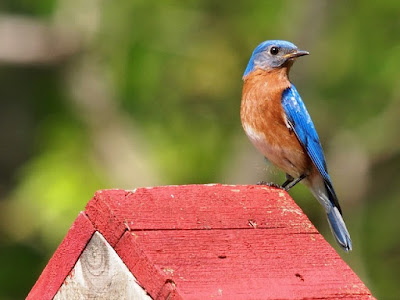 |
| Eastern Bluebird. skeeze. Pixabay |
Range in Arkansas: Eastern Bluebirds are year-round residents throughout Arkansas.
Identification:
Size: Larger than House Finches. Much smaller than starlings. About length of White-crowned Sparrow but differently proportioned.
Shape: Chunky, large head, short tail. Bill: Straight, fairly slender, curved at tip.
Color: Males are brilliant blue above (including wings and tail), rusty orange below with white belly and under tail. Females are often much paler, almost grayish.
Habitat, range & behavior: Found in pasture, fields, golf courses, open woodland edges.
They are resident in most of eastern US, highlands of Middle America. In summer reach northernmost eastern US and southernmost eastern Canada, withdrawing somewhat in winter.
They readily use nest boxes, but the entrance hole must be smaller than the head of a starling, and without a perch.
Food and feeder preference: They eat flying insects primarily, but also other invertebrates and berries. They will eat mealworms at your feeder and frequent birdbaths.
14. European Starling (Sturnus vulgaris)
Introduced to North America in the late 1800’s, they crossed the continent, often to the detriment of native cavity-nesting birds. The prime example of an invasive species.
 |
| European Starling. Greg Gillson |
Range in Arkansas: European Starlings are year-round residents throughout Arkansas.
Identification: This is a key species for comparing with an unknown bird.
Size: 8-1/2 inches from bill tip to tail tip. About the size of a Red-winged Blackbird. Smaller than an American Robin. Larger than a White-crowned Sparrow or Spotted/Eastern towhee.
Shape: Stocky with large head, short square-ended tail. Longer legs.
Bill: As long as head. Sharp pointed. Yellow in spring, otherwise dark.
Color: They are grayish brown much of the year, with glossy iridescence and white spotting during the spring.
Habitat, range & behavior: Lowland birds that need trees large enough for nest cavities but plenty of open area for feeding. They are most abundant in urban and suburban areas where they find food and artificial nest cavities.
Resident from coast-to-coast from southern Canada to northern Mexico. In summer north across Canada and Alaska. Native range is Europe to Pakistan, north Africa.
Often viewed as a pest, starlings often bully other backyard birds, taking over bird feeders, and stealing nest cavities from smaller native birds. In winter they can form into flocks of tens of thousands.
Food and feeder preference: Primarily insects when available, often feeding on the ground. Discourage them from your backyard hopper and tray feeders by never feeding birds table scraps (including bread or meat). They have weak feet and do not perch well on tube feeders. A cage mesh around smaller hopper feeders may keep them out.
15. American Goldfinch (Spinus tristis)
A beautiful tiny finch familiar to many in its bright yellow summer plumage. Colloquially called a “wild canary.”
 |
| American Goldfinch. Greg Gillson |
Range in Arkansas: American Goldfinches are year-round residents throughout Arkansas.
Identification: This is a key species for comparing with an unknown bird.
Size: Very small at about 5 inches from bill tip to tail tip. Similar in size to a chickadee. Larger than hummingbirds. Smaller than juncos and House Finches.
Shape: Tiny, somewhat plump with larger head and short tail.
Bill: Short, conical, pink.
Color: Males in summer are bright lemon yellow with black forehead and black wings and tail with white bars. White under tail coverts. Females are dull olive, wings and tail browner. Winter birds are pale grayish-yellow with tan and brown wings and tail.
Habitat, range & behavior: This species is found in weedy fields and similar clearings with thistles and similar plants.
It is found coast-to-coast throughout the year across most of the middle lower-48 states. In summer moves north to the Canada border. In the winter found south to the Mexico border.
The flight is highly undulating, rising and falling as they flap in short bursts. Besides a long, sweet lilting song, they call in flight a lilting 4-part: “potato chip!”
Food and feeder preference: Feeds on weed seeds, thistle seed. May eat black oil sunflower seeds from tube feeder. Love Nyjer seed in a feeder called a “thistle sock.”
You may like my in-depth article on attracting American Goldfinches.
16. Red-winged Blackbird (Agelaius phoeniceus)
These noisy flocking birds are most often found in marshes. But in winter they are found in backyards.
 |
| Male Red-winged Blackbird. Greg Gillson. |
 |
| Female Red-winged Blackbird. Greg Gillson. |
Range in Arkansas: Red-winged Blackbirds are year-round residents throughout Arkansas.
Identification: This is a key species for comparing with an unknown bird.
Size: About 8-3/4 inches long from bill tip to tail tip. About the size of a Northern Cardinal. Smaller than an American Robin.
Shape: Pot-bellied with a longer bill and flat forehead. Tail average.
Bill: Long and sharp pointed.
Color: Males are black with red and yellow shoulder patch. Females are streaked brown and rusty (sparrow-like but pointed bill and flat forehead).
Habitat, range, and behavior: Cattail marshes and wetlands are their summer habitat. In winter they feed in grain fields.
They breed across most of the North American continent. In winter they withdraw from most of Alaska and Canada.
They are found in colonies in summer and large flocks in winter.
Food and feeder preference: They eat insects in summer. In winter they eat grain and seeds. They visit feeders, more often in large winter flocks, and eat most seeds and suet.
17. Dark-eyed Junco (Junco hyemalis)
Colloquially called “snowbirds,” they often arrive in backyards in winter from nearby mountain forests or more northern climes.
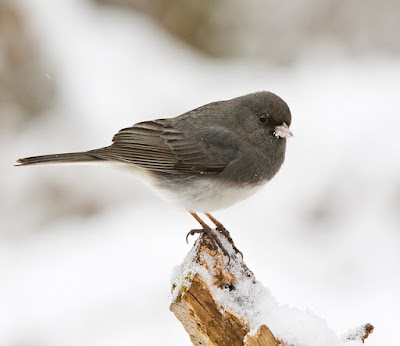 |
| Dark-eyed Junco. skeeze from Pixabay |
Range in Arkansas: Dark-eyed Juncos are winter visitors throughout Arkansas.
Identification:
Size: Small birds about the size of a House Finch.
Shape: Round body, short neck, round head, fairly long square-ended tail.
Bill: Short, pointed, conical, pink.
Color: Eastern birds are a darker all-gray with white belly. Western birds have jet black hood over head, brown back, and pink sides.
Habitat, range & behavior: Breed in coniferous forests. Winters widely. Avoids heavy brush, preferring widely spaced bushes.
Breeds across most of Canada, Alaska, and the western half of the United States. Winters from southern Canada and all of the lower 48-states to extreme northern Mexico.
Spend much of their time hopping and feeding on the ground.
Food and feeder preference: Eats mostly seeds, also insects in summer. Readily feed at backyard feeders on mixed seeds on hopper or tray feeders and ground.
You may like my in-depth article on attracting Dark-eyed Juncos.
18. White-breasted Nuthatch (Sitta carolinensis)
A favorite feeder bird for many for its active antics and fearlessness. Though a small bird it is the largest nuthatch in North America.
 |
| White-breasted Nuthatch. Greg Gillson |
Range in Arkansas: White-breasted Nuthatches are year-round residents throughout Arkansas.
Identification:
Size: About chickadee-sized in length. Smaller than a junco or House Finch.
Shape: Appears large-headed, neckless, very short tailed. Short legs.
Bill: Nearly as long as head, straight, thin.
Color: Blue-gray above, white below. Black cap, wing tips, tail. Rusty feathers under tail.
Habitat, range & behavior: Common in oak and oak-pine woodlands, wooded towns.
Found across the United States, southern Canada, mountains of central Mexico. Absent from treeless grasslands, deserts in the west.
Crawls over tree branches and head-first down tree trunks searching for insects.
Food and feeder preference: Insects, seeds, acorns and other nuts. Love black oil sunflower seeds feeding on hopper and tray feeders. Suet blocks.
19. House Finch (Haemorhous mexicanus)
These are one of the most common backyard birds in the United States. There are other red finches, but these are the ones most likely in residential areas.
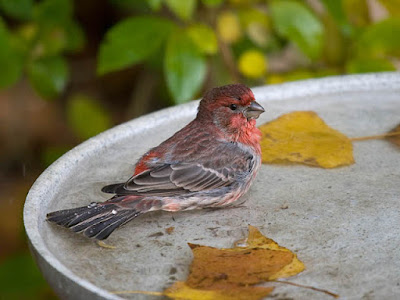 |
| House Finch. Greg Gillson. |
Range in Arkansas: House Finches are year-round residents throughout Arkansas.
Identification: This is a key species for comparing with an unknown bird.
Size: About 6 inches from bill tip to tail tip. Larger than goldfinches and chickadees. Smaller than a White-crowned Sparrows or Spotted/Eastern towhees.
Shape: Medium build with a medium-long notched tail. Round head.
Bill: Short, conical.
Color: Brown and gray above with streaks on the sides of the pale underparts. Males with red (sometimes orange or rarely yellow) crown, chest, rump.
Habitat, range & behavior: You’ll find small flocks on wires, in short tree tops and in bushes. Originally deserts and grasslands. Rural areas and towns are where they’re now most common.
Formerly found in the western United States and Mexico. Then introduced into the northeastern United States, but now found in nearly all of the lower-48 states and extreme southern Canada. Rare in plains states (Dakotas to Texas) and southern Florida.
House Finches are not territorial, but males sing throughout the year–a lively, wiry song ending in a couple of buzzy notes.
Food and feeder preference: House Finches love sunflower seeds and tube feeders. May eat from thistle socks.
You may like my in-depth article on attracting House Finches.
20. Northern Flicker (Colaptes auratus)
Of all the bird identification questions I get asked, this common larger backyard bird is the bird most people ask about. It doesn’t occur to those unfamiliar with it that this could be a woodpecker.
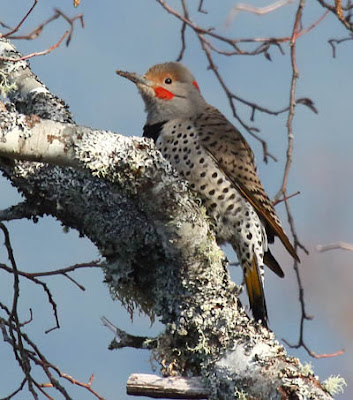 |
| Northern Flicker. Greg Gillson. |
Range in Arkansas: Northern Flickers are year-round residents throughout Arkansas.
Identification:
Size: About the size of a Mourning Dove. Larger than a robin.
Shape: Stocky with short legs, short tail, big head.
Bill: As long as head, thin, slightly curved.
Color: Back is brown with black bars. Under parts pinkish with black spots. Undersides of black wing and tail feathers are bright salmon red (West) or yellow (East). Head gray (West) or brown (East) and males with red (West) or black (East) whisker marks and nape marks (East). Black crescent across chest. White rump seen in flight.
Habitat, range & behavior: Found in woodland edges and forests.
Year-round resident from extreme southern Canada, across all of the lower-48 states and in the mountains of Mexico and Middle America. In summer breeds northward well into Canada and Alaska.
Frequently noted hopping on ground pecking in the ground for insects. In late spring, males proclaim their territory by rapid pounding on a hollow tree branch, though the ringing of metal downspouts at dawn is louder and carries much farther, to the exasperation of anyone trying to sleep inside!
Food and feeder preference: Ants and beetles are their primary foods. Will eat black oil sunflower seeds and are attracted to suet.
21. House Sparrow (Passer domesticus)
Like the starling, this is another bird introduced from Europe in the 1800’s. This sparrow is commonly found in cities and farmlands. It is considered a pest in most areas where it has been introduced.
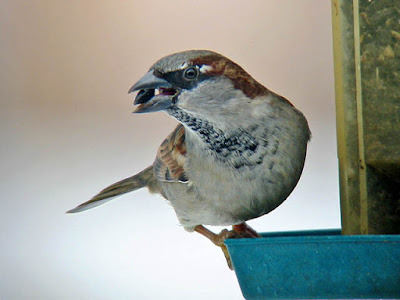 |
| House Sparrow. Greg Gillson |
Range in Arkansas: House Sparrows are year-round residents throughout Arkansas.
Identification:
Size: The size of a House Finch or Dark-eyed Junco.
Shape: Chunkier than native North American sparrows with large head, barrel chest, short neck, medium tail, short legs.
Bill: Short, conical.
Color: Males are brown and gray with a black mask. Females lack the black and are tan and brown with a pale line back from the eye.
Habitat, range & behavior: Cities and farms.
Range in North American from southern Canada through Central America. In summer northward through Canada to southern Alaska. Originated in Middle East and spread to most of Europe and Asia. Introduced in South America, Africa, Australia–nearly anywhere there are people and cities.
They tend to be messy… and have a good appetite, and may occur in large noisy chirping flocks. They are aggressive toward other feeder birds.
Food and feeder preference: They eat grain, seed, and insects. To discourage them from your hopper and tray feeders do not feed birds human food scraps. They have a bit of difficulty eating from tube feeders.
22. Common Grackle (Quiscalus quiscula)
Sometimes considered a pest to crops, grackles are longer and lankier than very similar blackbirds.
 |
| Common Grackle. GeorgiaLens from Pixabay |
Range in Arkansas: Common Grackles are year-round residents throughout Arkansas.
Identification:
Size: Larger than Red-winged Blackbirds, they are near the length of Mourning Doves.
Shape: Long, with long full keel-shaped tail, long legs, flat crown.
Bill: Longer than head, pointed, but stouter than other blackbirds.
Color: Glossy black with hint of bronze or green on head (depending upon population). Yellow eye.
Habitat, range & behavior: They are found in agricultural areas, woodland edges, city parks and lawns.
Resident in the southeastern United States. In summer they migrate northward and west to the central United States and Canada.
They monopolize feeders and are bullies toward other birds.
Food and feeder preference: Grain, corn, acorns, small aquatic fish and amphibians. To discourage them, use tube feeders, rather than hopper or tray feeders. Don’t over-feed, keep spilled seed picked up.
23. Indigo Bunting (Passerina cyanea)
Don’t mistake Indigo Buntings for the larger Blue Grosbeak. As the name suggests, the grosbeak has a much larger and thicker bill, along with rusty wing bars, lacking in Indigo Buntings.

Range in Arkansas: Indigo Buntings are summer residents throughout Arkansas.
Identification:
Size: These birds are a bit smaller than a House Sparrow.
Shape: Plump. Large round head. Medium short tail.
Bill: Large and conical.
Color: Males are deep blue. Females are pale gray-brown with diffuse streaks below.
Habitat, range & behavior: Open woodlands and clearings. Country farm roads.
They are found in the East and parts of the Southwest, north to southern Canada.
Sing from the tallest tip of tree or telephone lines, a cheerful paired bouncy song very similar to American Goldfinch. In fact, they are sometimes called “blue goldfinches” because of this!
Food and feeder preference: These birds will eat seeds from hopper feeders, perhaps more so in the late spring when they first arrive during migration.
24. Red-eyed Vireo (Vireo olivaceus)
This is one of the most common songbirds in eastern woodlands.

Range in Arkansas: Red-eyed Vireos are summer residents throughout Arkansas.
Size: Small, about the size of an American Goldfinch. Smaller than a House Finch.
Shape: Long and slim, but with rather short tail. Big-looking head.
Bill: Longer, stout. Pointed but small hook on end, as all vireos.
Color: They are olive-green above, white or with a hint of yellow below. Gray crown, bordered by black line, white eyebrow, and another thin black line through red eye.
Habitat, range & behavior: Tall deciduous trees, such as cottonwoods.
Breed across Canada, the Rocky Mountains and most of the East. Absent from much of the West and Southwest.
As with many vireos, they sing persistently through the summer and through the heat of the day, not just primarily during spring and at dawn as many other songbirds.
Food and feeder preference: They eat insects and will not come to feeders.
25. Brown-headed Cowbird (Molothrus ater)
Cowbirds are small blackbirds lay their eggs in the nests of other smaller birds, such as warblers. The adoptive parents raise their young!
 |
| Brown-headed Cowbird. Greg Gillson. |
Range in Arkansas: Brown-headed Cowbirds are year-round residents throughout Arkansas.
Identification:
Size: Larger than White-crowned Sparrows, but smaller than Rose-breasted or Black-headed Grosbeaks. Smaller than other blackbirds, starlings, and grackles.
Shape: Perhaps a little bit pot-bellied. Medium length tail. Flat forehead as typical for blackbirds.
Bill: Rather thick and stout.
Color: Males are glossy black with rich brown head. Females are dusty gray-brown throughout. Long-held juvenile plumage similar to pale female, scaly, being fed by Yellow Warbler or Song Sparrow or a hundred other host species.
Habitat, range & behavior: They are found in woodlands and farms. Also, with other blackbirds in winter at shopping center parking lots.
In summer they breed across Canada and most of the United States and Mexico. In winter they move south out of Canada and occupy both coasts and southeastern States in the US.
These small blackbirds join other flocks of blackbirds in cattle feedlots. You may see cowbirds riding on the backs of cattle, sheep, or horses. They originally rode on the backs of American bison on the Great Plains, but expanded when forests were cut.
Food and feeder preference: Cowbirds eat grains, seeds, and insects. They will readily come to hopper and platform feeders. They are larger and more aggressive, so keep other birds from feeders and have a big appetite!
26 Summer Tanager (Piranga rubra)
These bright red birds might be mistaken for cardinals. but are found higher in the trees where they eat bees, not seeds.

Range in Arkansas: Summer Tanagers are summer residents throughout Arkansas.
Identification:
Size: Bigger than a White-crowned Sparrow. Smaller than American Robin. About the size of Eastern Towhee.
Shape: Rather plump. Large head and bill. Full tail.
Bill: Fairly long and pointed. Swollen in the middle.
Color: Entire plumage bright red.
Habitat, range, & behavior: Deciduous woodlands.
They summer across the southern United States and in the mid-eastern United States. Winter in Mexico and South America.
Spend most of their time hidden toward tops of trees. Look for them in the tree canopy chasing bees in flight.
Food and feeder preference: Their diet is primarily bees and wasps but may eat fruit. Do not come to feeders.
Common Birds in Arkansas
To determine how common each species is I used the data from actual bird sightings from the citizen science program eBird. Birds are listed by frequency. That is, how often the species is recorded on checklists submitted to eBird (a percentage).
When choosing the birds to include in this article I leaned strongly to birds that are present throughout the year in good numbers. Thus, many of the common birds are year-round residents. This means that they live in the same location all year. They raise their young in your neighborhood. They don’t migrate. Or if the species does migrate, the ones living in your area don’t. If this is the case, some migrants may move into your area during certain times of year, adding to the same species that are in your yard full time.
Some migrant birds visit your yard during the “summer.” Often, they arrive in spring and remain until late fall. They nest and raise their young in your neighborhood. These are the summer residents.
Other migrant birds visit your backyard during the “winter.” Some of these winter visitors may arrive in July and remain into April. Others may only be found in the cold of December or January. They key here is that they nest and raise their young somewhere else. They only visit your yard in the non-breeding season.
Migration is an amazing spectacle.
There will be birds that fly through your region in spring or fall (or both). They may visit your backyard only a few days or weeks a year. They aren’t regular enough, or stay long enough, to be included in this article. But the number of briefly visiting migrant birds could double the number of species presented here. You may see them over time. Consult checklists in eBird for your county to see what is possible.
I have generally excluded common waterfowl, birds of prey, shorebirds, seabirds, and others that aren’t usually found in residential areas. But they may certainly fly over or be seen regularly if your home is on a shoreline, for instance.
Most common backyard birds in Arkansas throughout the year
The following list is the backyard birds that are, on average, most common throughout the entire year. The list is ordered by most common based on the frequency of how often each species is recorded on checklists submitted to eBird.
- Northern Cardinal (62% frequency)
- Blue Jay (50%)
- American Crow (47%)
- Carolina Chickadee (46%)
- Tufted Titmouse (42%)
- Carolina Wren (41%)
- Red-bellied Woodpecker (40%)
- Mourning Dove (39%)
- Downy Woodpecker (32%)
- American Robin (32%)
- Northern Mockingbird (30%)
- White-throated Sparrow (28%)
- Eastern Bluebird (25%)
- European Starling (24%)
- American Goldfinch (24%)
- Red-winged Blackbird (21%)
- Dark-eyed Junco (21%)
- White-breasted Nuthatch (20%)
- House Finch (20%)
- Northern Flicker (17%)
- House Sparrow (17%)
- Common Grackle (16%)
Most common backyard birds in Arkansas in winter
- Northern Cardinal (60% frequency)
- Carolina Chickadee (49%)
- Dark-eyed Junco (47%)
- Blue Jay (47%)
- White-throated Sparrow (46%)
- American Crow (46%)
- Tufted Titmouse (42%)
- Red-bellied Woodpecker (41%)
- Carolina Wren (38%)
- Downy Woodpecker (37%)
- American Goldfinch (34%)
- Mourning Dove (34%)
- American Robin (32%)
- Northern Mockingbird (28%)
- Eastern Bluebird (28%)
- Northern Flicker (25%)
- European Starling (25%)
- White-breasted Nuthatch (23%)
- House Finch (20%)
Most common backyard birds in Arkansas in summer
- Northern Cardinal (61% frequency)
- Blue Jay (47%)
- Mourning Dove (45%)
- American Crow (44%)
- Carolina Wren (42%)
- Tufted Titmouse (41%)
- Indigo Bunting (41%)
- Carolina Chickadee (37%)
- Northern Mockingbird (33%)
- Red-bellied Woodpecker (32%)
- American Robin (29%)
- Red-eyed Vireo (27%)
- Downy Woodpecker (26%)
- House Sparrow (24%)
- Brown-headed Cowbird (22%)
- Sumer Tanager (22%)
- European Starling (21%)
How do birds differ between winter and summer?
Carolina Chickadees, Dark-eyed Juncos, White-throated Sparrows, Downy Woodpeckers, American Goldfinches are more common in winter.
Mourning Doves, Indigo Buntings, Red-eyed Vireos, Summer Tanagers are more common in summer.
Common Backyard Birds of Little Rock, Arkansas
 |
| Mourning Doves. Greg Gillson |
- Northern Cardinal (66% frequency)
- Blue Jay (58%)
- Carolina Chickadee (54%)
- Mourning Dove (53%)
- American Robin (51%)
- Northern Mockingbird (48%)
- Carolina Wren (48%)
- Red-bellied Woodpecker (47%)
- Tufted Titmouse (43%)
- Downy Woodpecker (43%)
- American Crow (39%)
- House Finch (38%)
- House Sparrow (37%)
- White-throated Sparrow (37%)
- European Starling (30%)
- White-breasted Nuthatch (25%)
- Eastern Bluebird (23%)
- Northern Flicker (23%)
- Common Grackle (22%)
- Dark-eyed Junco (22%)
- American Goldfinch (21%)
Mourning Doves, American Robins, Northern Mockingbirds, Downy Woodpeckers, House Finches, House Sparrows, White-throated Sparrows are more common in Little Rock than in the state as a whole.
These are all common in residential areas, which probably accounts for them being more common in Little Rock.
Wrapping Up
Arkansas boasts a rich and diverse bird population, with over 400 species recorded within its borders. Here are some of the most common birds you might encounter outside your backyard, depending on the habitat and season:
Open Fields and Grasslands:
- Western Meadowlark: This Wyoming state bird, often seen in Arkansas, exhibits a bright yellow breast, black V-mark on its chest, and a long, melodious song. Look for them perched on fence posts or singing from open fields.
- Eastern Bluebird: These sky-blue beauties with rusty orange breasts add a touch of elegance to parks, orchards, and open woodlands. Their melodious songs are a delight to hear.
- Common Grackle: Large and black with iridescent purple highlights, these social birds form large flocks and frequent open fields, farmland, and marshes.
Forests and Woodlands:
- Downy Woodpecker: Small but vibrant, these black and white woodpeckers drum on trees and sport a bright red patch on the nape of their neck. You’ll find them in various wooded habitats.
- Blue Jay: These bold and vocal birds flash their stunning combination of blue, black, and white through forests and woodlands. Keep an eye out for their acrobatic displays and loud calls.
- Carolina Wren: These small, brown birds with a long, white eyebrow readily flit through undergrowth and sing beautiful, complex songs.
Mountain Regions:
- Dark-eyed Junco: These gray sparrows with white wing bars and pink beaks are common ground feeders in forested areas, readily hopping and foraging under trees.
- American Goldfinch: During breeding season, these tiny birds transform into sunshine on wings, with bright yellow bodies, black caps, and black wing bars. You’ll find them in fields, meadows, and gardens.
- Wild Turkey: These large, majestic birds with bronze feathers and distinctive strutting walk prefer wooded areas and can be spotted in various parts of the state.
Frequently Asked Questions
What is the state bird of Arkansas?
The state bird of Arkansas is the Northern Mockingbird! These talented songbirds impress with their complex vocal mimicry, mimicking the sounds of other birds, frogs, and even mechanical noises. With their gray plumage, white wing bars, and long tails, they are readily recognizable across the state.
The Northern Mockingbird was designated as the state bird in 1929, thanks to the efforts of the Arkansas Federation of Women’s Clubs. Their impressive singing abilities and adaptability to various habitats made them a fitting symbol for the state’s natural beauty and diversity.
What are the tiny black and white birds in Arkansas?
There are several possibilities for tiny black and white birds in Arkansas, depending on the details of your observation like size, habitat, and time of year. Here are some likely candidates:
- Black-and-white Warbler: These lively warblers flit through tree branches in forests and woodlands, displaying a striking black and white pattern with a white throat and wing bars.
- Black-capped Chickadee: These energetic, inquisitive birds with a black cap and bib readily visit feeders and flit through trees, adding a touch of cheer to any landscape.
- Yellow Warbler: While primarily yellow, males of this warbler species have black streaks on their face and breast during breeding season, creating a black and white effect. Look for them in dense vegetation of forests and parks.
- Downy Woodpecker: Small but vibrant, these black and white woodpeckers drum on trees and sport a bright red patch on the nape of their neck. You’ll find them in various wooded habitats.
- Carolina Chickadee: Similar to the Black-capped Chickadee but with brown flanks and a gray cap, they frequent woodlands and forests, readily visiting feeders.
The Brown-headed Cowbird, with its unassuming brown plumage and fascinating life strategy, might seem like a plain bird at first glance. But delve deeper, and you’ll discover a creature packed with intriguing facts that redefine avian norms:
- Nest Raiders: Cowbirds ditch the nest-building and chick-rearing responsibilities altogether. They lay their eggs in the nests of other birds, leaving the unsuspecting hosts to raise their young as their own.
- Species Hoppers: They target over 220 bird species! Their flexible egg-laying schedule allows them to parasitize diverse hosts, from tiny warblers to larger jays.
- Egg Mimicry: Cowbird eggs often resemble the host’s eggs in size and color, increasing the chances of acceptance, although some vigilant hosts recognize and eject the imposters.
- Egg Assassins: When their eggs hatch first, cowbird chicks can push or smother the host’s chicks out of the nest, ensuring all resources go to their own survival.
- Rapid Growth: Cowbird chicks grow faster than the host’s, further increasing their competitive advantage and securing more food from the foster parents.
- Vocal Mimicry: Some cowbird chicks even mimic the begging calls of the host species’ chicks, manipulating the foster parents into providing them with extra care.
Related Articles:
Red, Orange, & Yellow Birds of Arkansas
34 of the most common birds in the United States (with photos)







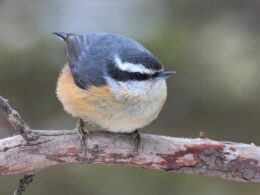



I would love to be able to print this article. We recently bought property in NWA and I am in love with all the local birds. I've made a binder of articles and facts on certain local birds but this is even better! Is there a way for me to print this easily? Thanks ~Amber~
Place your cursor in the text hold down or right click. Select all. Copy.
Go to word processor. Paste.
There it is.